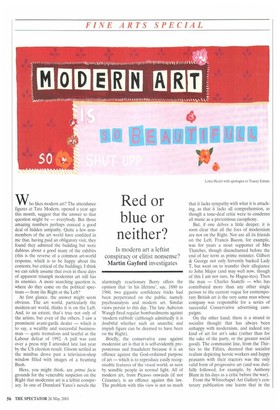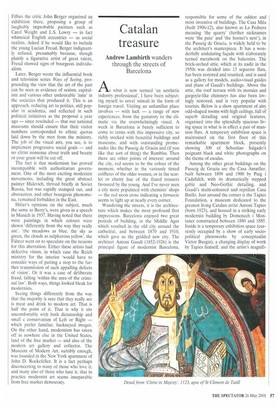Red or blue or neither?
Is modern art a leftist conspiracy or elitist nonsense? Martin Gayford investigates
Who likes modern art? The attendance figures at Tate Modern, opened a year ago this month, suggest that the answer to that question might be — everybody. But those amazing numbers perhaps conceal a good deal of hidden antipathy. Quite a few nonmembers of the art world have confided in me that, having paid an obligatory visit, they found they admired the building but were dubious about a good many of the exhibits (this is the reverse of a common art-world response, which is to be happy about the contents, but critical of the building). I think we can safely assume that even in these days of apparent triumph modernist art still has its enemies. A more searching question is, where do they come on the political spectrum — from the Right or the Left?
At first glance, the answer might seem obvious. The art world, particularly the modern-art world, thinks it is on the Left. And, to an extent, that's true not only of the artists, but even of the others. I saw a prominent avant-garde dealer — which is to say, a wealthy and successful businessman — quite tremulous and tearful at the Labour defeat of 1992. A pall was cast over a press trip I attended late last year by the US election result. Gloom settled as the minibus drove past a television-shop window filled with images of a beaming Bush.
Here, you might think, are prima facie grounds for the venerable suspicion on the Right that modernist art is a leftist conspiracy. In one of Dornford Yates's novels the
alarmingly reactionary Berry offers the opinion that 'in his lifetime', say, 1880 to 1960, two gigantic confidence tricks had been perpetrated on the public, namely psychoanalysis and modern art. Similar views persist to this day. The late Auberon Waugh fired regular bombardments against 'modern rubbish' (although admittedly it is doubtful whether such an anarchic and impish figure can be deemed to have been on the Right).
Briefly, the conservative case against modernist art is that it is self-evidently preposterous and fraudulent because it is an offence against the God-ordained purpose of art — which is to reproduce easily recognisable features of the visual world, as seen by sensible people in normal light. All of modern art, from Picasso onwards (if not Cezanne), is an offence against this law. The problem with this view is not so much that it lacks sympathy with what it is attacking, as that it lacks all comprehension, as though a tone-deaf critic were to condemn all music as a pretentious cacophony.
But, if one delves a little deeper. it is soon clear that all the foes of modernism are not on the Right. Nor are all its friends on the Left. Francis Bacon, for example, was for years a stout supporter of Mrs Thatcher, though disenchanted before the end of her term as prime minister. Gilbert & George not only fervently backed Lady T, but went on to transfer their allegiance to John Major (and may well now, though of this I am not sure, be Hague-ites). Then the man — Charles Saatchi — who has contributed more than any other single person to the current vogue for contemporary British art is the very same man whose company was responsible for a series of successful Conservative advertising campaigns.
On the other hand, there is a strand in socialist thought that has always been unhappy with modernism, and indeed any kind of art for art's sake (rather than for the sake of the party, or the greater social good). The communist line, from the Thirties to the Fifties, decreed that socialist realism depicting heroic workers and happy peasants with their tractors was the only valid form of progressive art (and was dutifully followed, for example, by Anthony Blunt in his days as a critic before the war).
From the Whitechapel Art Gallery's centenary publication one learns that in the Fifties the critic John Berger organised an exhibition there, proposing a group of laughably improbable painters such as Card l Weight and L.S. Lowry — in fact whimsical English eccentrics — as social realists. Asked if he would like to include the young Lucian Freud, Berger indignantly refused, presumably because, though plainly a figurative artist of great talent, Freud showed signs of bourgeois individualism.
Later, Berger wrote the influential book and television series Ways of Seeing, propounding the view that the art of the past can be seen as evidence of sexism, capitalism and various other undesirable 'isms' in the societies that produced it. This is an approach, reducing art to politics, still popular in academia, and reflected in such political initiatives as the proposal a year ago — since rescinded — that our national museums should ensure that their visitor numbers corresponded to ethnic quotas laid down by the men from the ministry. The job of the visual arts, you see, is to implement progressive social goals — and no elitist nonsense about truth and beauty or your grant will be cut off.
The fact is that modernism has proved incompatible with authoritarian govern. ment. One of the most exciting modernist movements, including the great abstract painter Malevich, thrived briefly in Soviet Russia, but was rapidly stamped out, and abstraction, and other bourgeois phenomena, remained forbidden in the East.
Hitler's opinions on the subject, much the same as Berry's, were given in a speech in Munich in 1937. Having noted that there were paintings in which colours were shown 'differently from the way they really are', the meadows as blue, the sky as green, the clouds as sulphurous yellow', the Fiihrer went on to speculate on the reasons for this aberration. Either these artists had defective vision, in which case the Reich ministry for the interior 'would have to consider ways of putting a stop to the further transmission of such appalling defects of vision'. Or it was a case of deliberate fraud, falling 'within the area of the criminal law'. Both ways, things looked bleak for modernists.
Seeing things differently from the way that the majority is sure that they really are is meat and drink to modern art. That is half the point of it. That is why it sits uncomfortably with both dictatorship and small c conservatism of Left or Right — which prefer familiar, hackneyed images. On the other hand, modernism has taken off as nowhere else in the United States, land of the free market — and also of the modern art gallery and collector. The Museum of Modern Art, suitably enough, was founded in the New York apartment of John D. Rockefeller. It is a fact perhaps disconcerting to many of those who love it, and many also of those who hate it, that in practice modernist art seems inseparable from free market democracy.



















































































 Previous page
Previous page